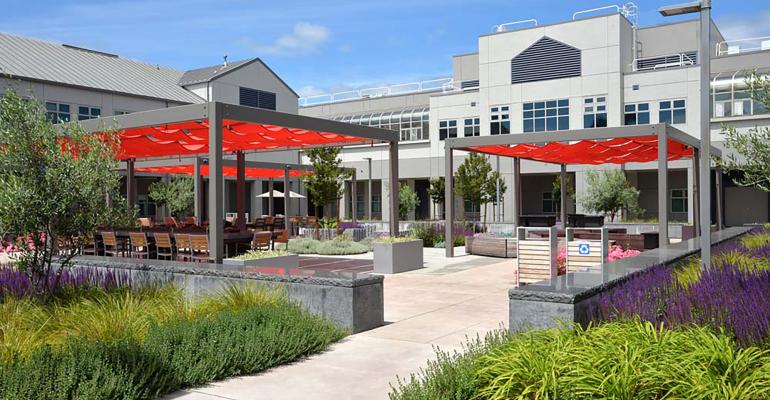While local, state and national leaders are tailoring strategies to respond to COVID-19, most agree on one thing: You still need to get outside to connect with nature and your neighbors while getting exercise to maintain your physical and mental health. With that renewed connection to the outdoors, one impact of the crisis we’re seeing in the early design responses to the crisis is based on that fundamental, health-based connection to the outdoors—resulting in more adjacent outdoor space for office buildings, more plaza and sidewalk dining in retail, and more parks and greenspace in private—and public-sector real estate strategies.
Like millions of Americans, we’ve become much better acquainted with the walkable streets in our neighborhoods, the nearby trails and “ahh-hah” outdoor spaces like pocket-parks, vista points and hidden gardens. We’re all appreciating these spaces more.
Why do we need more outdoor spaces? It’s common sense that sunshine, fresh air and exercise are good for you. But there’s also an increasing body of deep scientific research proving our human need to be outdoors, and also documenting the downside of not getting enough access to the outdoor world.
In our work across nearly 40 years in landscape architecture and urban planning, we have helped private and public organizations use this body of evidence in designing outdoor spaces that benefit employees, customers, students, patients and visitors.
Some of the more impactful research includes:
Green views improve health
An oft-cited 1984 study by Roger Ullrich reported in Science magazine compared hospital surgery patients who had a blank-wall view outside their window, to patients with a tree view. Those with a view of nature had shorter postoperative hospital stays, took fewer analgesic doses of medication, and had slightly lower scores for postsurgical complications.
In a new 2020 study, researchers also found exposure to ultra-violet (UV) sunlight improved conditions for people with high blood pressure. Lead author Dr. Richard Weller of the University of Edinburgh said the observational study was the first time a large research study has shown a lowering of systolic blood pressure from UV exposure, regardless of outdoor temperature.
Now many hospitals, veterans facilities, senior housing communities and other life and health facilities follow evidence-based design recommendations to create healing gardens and outdoor greenspace. A 2014 book by UC-Berkeley professor emerita Clare Cooper Marcus and alumna Naomi Sachs, Therapeutic Landscapes, has influenced design with proven techniques for spaces to reduce stress, support recovery, help patients regain impaired abilities, and encourage emotional equilibrium.
For example, John Muir Regional Medical Center includes both a rooftop healing garden and extensive outdoor greenspace for enhanced views of nature and spaces for patients, staff and visitors to relax and recharge.
Sunlight and outdoor connections for health, productivity
Appropriate exposure to daylight and the outdoors is also good for cognition, as shown in research showing benefit on student test scores, worker productivity and more.
A 2009 study at the University of Michigan found that people who walked for 50 minutes in nature performed significantly better on memory-related tasks than did subjects who walked in a more sterile, urban environment.
The benefits on Productivity and human performance also drive design decisions for commercial office, retail, educational and other developments.
A key study in 1999 by Heschong Mahone Group on behalf of the California Board for Energy Efficiency and PG&E found a statistically compelling connection between daylighting and student performance, and between skylights and retail sales. In its most-cited findings, the report showed students in classrooms with more natural light scored as much as 25 percent higher on standardized tests than other students in the same school district.
Many of the technology campuses in Silicon Valley have recognized the benefits of “getting people outside“ on the design of their campuses.
Most recently, the PG&E San Ramon Conference Center redesigned its landscape architecture to create extensive “outdoor rooms” and accessible greenspace that support successful meetings and productivity.
This body of research is also foundational for spaces we see and use most every day, often without noticing, including local parks and green streetscapes.
A Canadian study quantified several such benefits of tree line streetscapes and well-connected park system. The Ontario Health Study, researching general health and tree density in Toronto while also controlling for demographic factors, found that having 10 more trees on a city block improved perceived health on par with being seven years younger or $10,000 a year richer.
New housing developments such as the Innovation community in Fremont, Calif., and Ellis community in Tracy, Calif., have multiple parks linked with multi-use trails providing green, enjoyable spaces easily accessed by every home. Traditional public parks, when open, are crucial community amenities such as San Tomas park in Silicon Valley with its diverse range of uses to appeal to a cross-section of the community including a large community garden.
With the pandemic forcing people to shelter in place and cherish their neighborhood walks, there’s a renewed appreciation for the parks, trails and landscaped spaces that will likely extend beyond the current health crisis.
As we rethink our built world in response to lessons of the coronavirus, we need to maximize access to the outdoor environment and its lasting health benefits. This is especially true in design of medical facilities, schools, office environments, restaurant dining, senior facilities, residential communities and parks.
In short, we need more space, and more effectively designed green and accessible spaces, so we can get outside for better health.
Casey Case is president and Linda Gates is co-founder of Gates & Associates, a landscape architecture and urban design firm in San Ramon, Calif., creating sustainable, extraordinary places for commercial and residential real estate firms and public sector clients in California and the Western U.S. For more information, visit us at www.dgates.com





